スウェーデンの王立科学アカデミーは9日、リチウムイオン電池の開発に寄与した3人にノーベル化学賞を贈ると発表した。リチウムイオン電池が「モバイルの世界を可能にした」と評価している。
米テキサス大学オースティン校のジョン・B・グッドイナフ教授(97)、ニューヨーク州立大学ビンガムトン校のM・スタンリー・ウィッティンガム教授(77)、そして日本の旭化成名誉フェローで名城大学教授の吉野彰氏(71)の3人。900万スウェーデンクローナ(約9700万円)の賞金は3人で分け合う。
グッドイナフ氏は、ノーベル賞受賞時の年齢としては史上最高齢。
リチウムイオン電池は軽く、再充電が可能な電池で、携帯電話やラップトップ、電気自動車(EV)などに利用されている。また、太陽光発電や風力発電といった再生可能エネルギーの蓄電にも活用されている。
The Nobel Prize in Chemistry 2019
https://www.nobelprize.org/prizes/chemistry/2019/summary/
Announcement of the Nobel Prize in Chemistry 2019
授賞のテーマが少し物理に近いこと、私たちの生活にあまりにも密着していること、中学生や高校生の関心も引くことから、今年は物理学賞だけでなく化学賞についてもブログ記事を書くことにした。
以下が発表と授賞の解説で映されたスライドである。
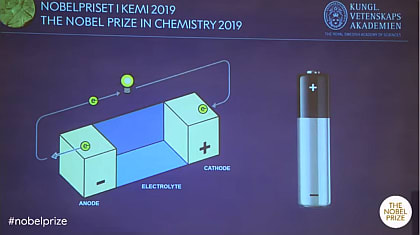
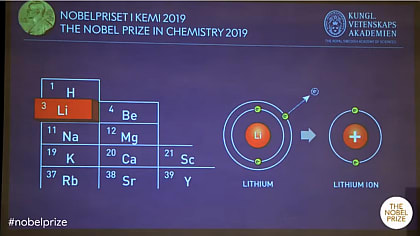

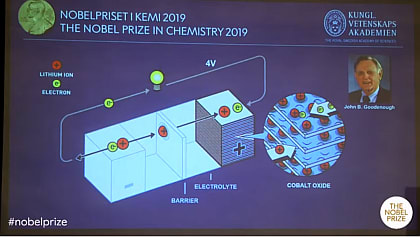
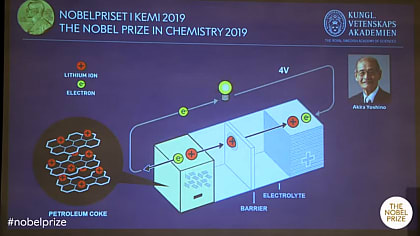
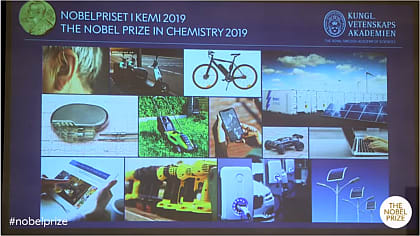
発表のタイミングで公開されたプレスリリースを和訳したものを載せておこう。
プレスリリース(英語):
https://www.nobelprize.org/uploads/2019/10/press-chemistry-2019-2.pdf
日本語訳:
2019年ノーベル化学賞
ジョン・B・グッドイナフ
米テキサス大学オースティン校
M・スタンリー・ウィッティンガム
米ニューヨーク州立大学ビンガムトン校
吉野彰
旭化成名誉フェロー、日本
名城大学、名古屋、日本
“リチウムイオン電池の開発に対して授賞”
彼らは繰り返し充電可能な世界を創造した
2019年のノーベル化学賞はリチウムイオン電池の開発に対して授賞する。この軽量で、繰り返し充電可能で強力な電池はスマートフォンからノートPC、自動車まであらゆるものに使われている。またこの電池は太陽光や風力から得られるとてつもなく大きなエネルギーを蓄えることができるようになり、脱化石燃料社会の実現を可能にした。
リチウムイオン電池は、私たちの連絡、仕事、学習、音楽視聴、知識の検索などの手段となる携帯型電子機器のために全世界で使われている。リチウムイオン電池はまた、長距離走行可能な電気自動車および太陽光発電や風力発電など再生可能なエネルギーの蓄電を可能にした。
リチウムイオン電池の基礎は、1970年代の石油危機に始まった。スタンリー・ウィッティンガム博士は、脱化石燃料技術に結びつく手法の開発に尽力した。博士は超伝導体の研究を始め、革新的なリチウムイオン電池の陽極を作成するために使用される極めて高いエネルギーをもつ物質を発見した。これは分子レベルでリチウムイオンを挿入(インターカレート)する領域をもつチタン・ジスフィルドという物質だ。
このバッテリーの陰極には部分的に金属リチウムが含まれ、これによって電子を強力に放出することができる。その結果、2ボルトを超える文字通り素晴らしいポテンシャルをバッテリーにもたらした。しかしながら、金属リチウムは反応性に富んでいることから、使用する前に爆発しやすいという問題もある。
ジョン・グッドイナフ博士は、金属ジスフィルドのかわりに金属酸化物を使うことで陽極に、より大きなポテンシャルを持たせられることを予想した。組織的に探索した結果、1980年に博士は酸化コバルトを挿入したリチウムイオンが4ボルト(の電圧)を生み出すことを示した。これはより強力な電池に結びつく重要なブレイクスルーとなった。
吉野彰博士は、グッドイナフ博士の陽極を基礎として1985年に商用的に実現可能なリチウムイオン電池を作成した。陰極に反応性に富むリチウムを使わないもので、博士は陽極に酸化コバルトを挿入するのではなく、炭素材料の石油コークスを使用してリチウムイオンに挿入した。
その結果、軽量で耐久性があり、性能が低下するまで数百回も繰り返し充電可能なリチウムイオン電池が実現した。リチウムイオン電池の利点は、陰極と陽極をリチウムイオンが行き来するだけであり、両電極を破壊する化学反応ではないことだ。
リチウムイオン電池は1991年に商用化されて以来、私たちの生活に革命をもたらしてきた。それは無線の社会、脱化石燃料社会の基礎として拡がり、人類にとてつもない利益をもたらすものである。
グッドイナフ博士、ウィッティンガム博士、吉野博士、化学賞受賞おめでとうございます。
吉野彰博士の記者会見
ノーベル化学賞の旭化成・吉野彰氏、満面の笑顔で受賞会見(2019年10月9日)
ノーベル化学賞の旭化成・吉野彰氏が夫妻で会見 発表から一夜明け(2019年10月10日)
2つめの記者会見で吉野博士は「もし自分が旭化成ではなく電池メーカーで働いたとしたら、ノーベル化学賞に結びつく素材からの開発はできなかっただろう。」とおっしゃっている。
関連書籍:
吉野彰博士の著書: 書籍を検索
リチウムイオン電池: 書籍を検索 Kindle書籍を検索
吉野博士が科学(化学?)に興味をもったのは、小学生のとき読んだマイケル・ファラデーの「ロウソクの科学」がきっかけだった。2016年のノーベル生理学・医学賞を受賞した大隅良典博士が大きな影響を受けた本としても知られている。
「ロウソクの科学 (角川文庫):マイケル・ファラデー」(Kindle版)
「ロウソクの科学 (岩波文庫):マイケル・ファラデー」(Kindle版)

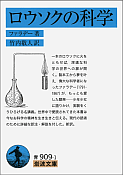
次はファラデーの講演を紙上に再現。今までの国内翻訳書にはない、再現可能な実験の写真や図解を掲載し、完訳ではなく抄訳によって、話の流れをわかりやすくした本だ。
「「ロウソクの科学」が教えてくれること 炎の輝きから科学の真髄に迫る、名講演と実験を図説で(サイエンス・アイ新書)」(Kindle版)
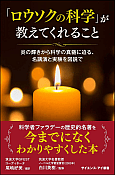
原書はこちら。Kindle版には「無料の本」を含め「さまざまな本」がある。
「The Chemical History of a Candle: Michael Faraday」(Kindle版)
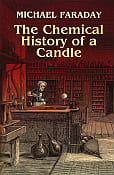
メルマガを書いています。(目次一覧)

応援クリックをお願いします。







英語原文:
The Nobel Prize in Physics 2019
John B. Goodenough
The University of Texas at Austin, USA
M. Stanley Whittingham
Binghamton University, State University of New York, USA
Akira Yoshino
Asahi Kasei Corporation, Tokyo, Japan
Meijo University, Nagoya, Japan
“for the development of lithium-ion batteries”
They created a rechargeable world
The Nobel Prize in Chemistry 2019 rewards the development of the lithium-ion battery. This lightweight, rechargeable and powerful battery is now used in everything from mobile phones to laptops and electric vehicles. It can also store significant amounts of energy from solar and wind power, making possible a fossil fuel-free society.
Lithium-ion batteries are used globally to power the portable electronics that we use to communicate, work, study, listen to music and search for knowledge. Lithiumion batteries have also enabled the development of long-range electric cars and the storage of energy from renewable sources, such as solar and wind power.
The foundation of the lithium-ion battery was laid during the oil crisis in the 1970s. Stanley Whittingham worked on developing methods that could lead to fossil fuel-free energy technologies. He started to research superconductors and discovered an extremely energy-rich material, which he used to create an innovative cathode in a lithium battery. This was made from titanium disulphide which, at a molecular level, has spaces that can house – intercalate – lithium ions.
The battery's anode was partially made from metallic lithium, which has a strong drive to release electrons. This resulted in a battery that literally had great potential, just over two volts. However, metallic lithium is reactive and the battery was too explosive to be viable.
John Goodenough predicted that the cathode would have even greater potential if it was made using a metal oxide instead of a metal sulphide. After a systematic search, in 1980 he demonstrated that cobalt oxide with intercalated lithium ions can produce as much as four volts. This was an important breakthrough and would lead to much more powerful batteries.
With Goodenough's cathode as a basis, Akira Yoshino created the first commercially viable lithium-ion battery in 1985. Rather than using reactive lithium in the anode, he used petroleum coke, a carbon material that, like the cathode's cobalt oxide, can intercalate lithium ions.
The result was a lightweight, hardwearing battery that could be charged hundreds of times before its performance deteriorated. The advantage of lithium-ion batteries is that they are not based upon chemical reactions that break down the electrodes, but upon lithium ions flowing back and forth between the anode and cathode.
Lithium-ion batteries have revolutionised our lives since they first entered the market in 1991. They have laid the foundation of a wireless, fossil fuel-free society, and are of the greatest benefit to humankind.